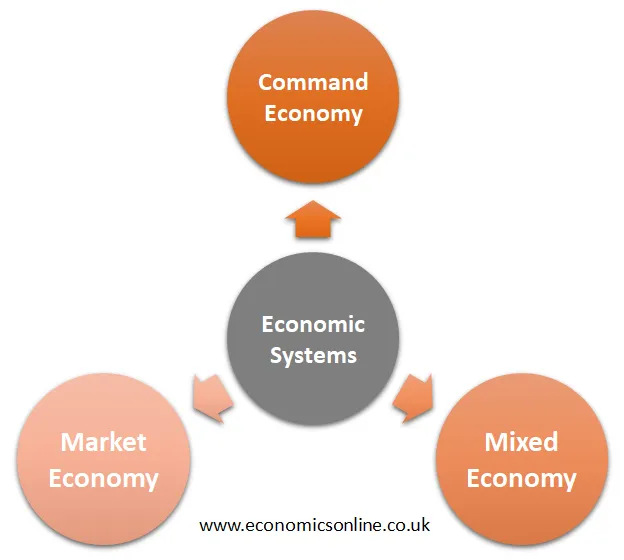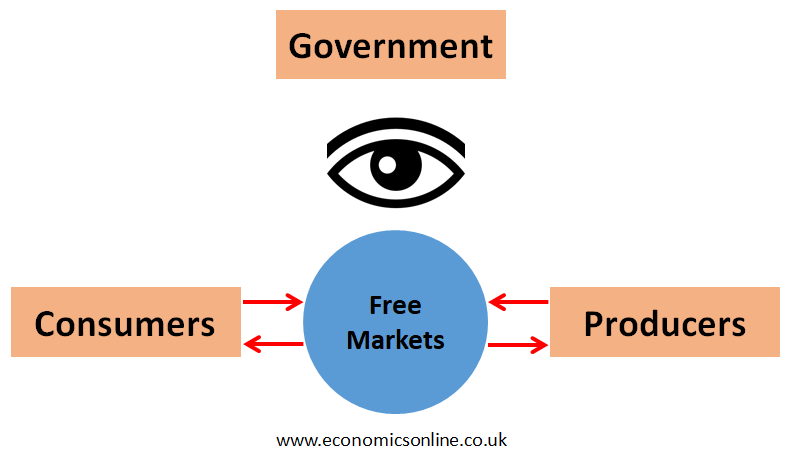
A futuristic image of a glass building in a market economy.
Disadvantages of Market Economy
Introduction
An economy is an area where goods and services are produced to satisfy the needs and wants of people. Every economy has a resource allocation mechanism, which is called the economic system.
Three types of economic systems are the command economy, the market economy, and the mixed economy.

In this article, we will discuss the market economy in detail.
What is a Market Economy?
Market economy refers to a type of economic system in which resource allocation decisions are taken by households and firms using price mechanism with no government intervention.
It is also called the free market economy. Its key features are the private ownership of resources, the profit motive, and the price mechanism. In a market economy, individuals have the freedom to make investment decisions, such as conducting a detailed comparison of gold IRA options, reflecting the system’s emphasis on personal financial choice and resource allocation.
Characteristics of Market Economy
The following are the main characteristics of a market economy:
Private Ownership
The private ownership of resources is a major feature of a market economy. The market economy allows individuals and businesses to have ownership of their private resources, such as property and other resources used for manufacturing. Individuals and businesses have the right to ownership and control over the use of these resources.
Free Market
In a market economy, buyers and sellers are free in their dealings in the marketplace. The prices of goods and services are also determined by the demand and supply of that particular product in the market. In a free market, there is no government influence over the buying and selling of goods and services.
Price Mechanism
The price mechanism, determined by the forces of demand and supply, plays a significant role in resource allocation. It serves as a signal for producers and consumers to adjust their behaviour.
Competition
In the market economy, businesses compete with each other in the same industries to attract customers. This competition is necessary for innovation, productivity, enhancing the quality of products, and the efficiency of businesses in the marketplace.
Profit Motive
Businesses are motivated to produce high profits by producing goods or services and selling them at highly competitive prices according to consumer demand. The decisions of producers and consumers are based on their own self-interest.
Consumer Sovereignty
In a market economy, consumer sovereignty is the main characteristic. This means that consumers are free to choose their preferences and decisions on their own.
The Role of Government
There is no direct government intervention in the functioning of the market economy, and the government does not interfere in the operation of the price mechanism. The role of the government is to just watch what is going on in the market and make no interference.

For the better working of the market economy, the government ensures law and order through the police and judiciary. It controls the money supply through its printing and circulation. It also imposes regulations for contracts and property rights to encourage fair competition and protect consumers from fraudulent activities.
Examples of Market Economy
There is no perfect example of a 100% pure market economy in the world. Here are some examples of countries that are relatively close to a market economy.
The United States of America
In the United States, businesses and individuals compete freely in the marketplace with different industries, where consumers feel free to choose what to buy and where to buy. There is little to no government intervention. The size of the public sector is smaller as compared to the private sector which makes the United States a close example of a market economy.
Singapore
Another close example of a relatively free market economy is Singapore. There is freedom to make economic decisions and government intervention is minimal.
Australia
Another close example of a market economy is Australia, where the allocation of resources and pricing of products are only determined by market forces and not by the government.
Advantages of Market Economy
The following are the advantages of a market economy:
Efficiency
When resources are allocated based on the demand and supply of the products, market economies tend to be more efficient. Businesses are free to make decisions and produce their particular goods and services efficiently resulting in maximising profits by using minimum resources. This helps maximise efficiency in the market economy.
Innovation
Innovation plays a major role in the market economy. Businesses are encouraged to compete effectively in the market economy, produce new products and services, and adopt strategies to attract consumers. This innovation stimulates economic growth while also updating the living standards of consumers.
Consumer Choice
In a market economy, consumers are free to choose from different products and services offered in markets at different prices. Firms provide a wide range of products and services, competing at different levels just to maximise their profits. Consumer choice is more important where they are free to choose the product or service based on their income bracket.
Economic Growth
The market economy also stimulates economic growth in a country. It allows businesses to expand independently, resulting in an increase in job opportunities, which is beneficial for economic development.
Flexibility
The market economies are flexible. When consumer preferences change, prices and resources are adapted to manage the shift in demand and supply of products and services, encouraging the economy to respond quickly to these changes.
Disadvantages of Market Economy
The following are the major disadvantages of a market economy:
Inequality
The hunt for profit results in the unequal distribution of resources or income among individuals. The market economy is the major cause of income and resource inequality among individuals and business entities in a country.
Externalities
Externalities are the negative or positive effects on society due to the economic decisions of producers and consumers. Pollution caused by production is an example of a negative externality. Costs and benefits related to externalities are not properly addressed by market economies, which leads to under- or over-allocation of resources.
Public Goods
Public goods such as street lights and defense may not be provided by private producers in a market economy. The non-excludability and non-rivalry features of public goods make it unprofitable for private businesses to provide public goods.
Merit Goods
Merit goods like education and health services are under-consumed and under-produced in a market economy due to information failure. As a result, there is an under-allocation of resources for these goods by the free market and private producers.
Demerit Goods
Demerit goods like cigarettes and junk food are overconsumed and overproduced in a market economy due to information failure. As a result, there is an overallocation of resources on these goods by the free market and private producers.
Market Failures
Market failures arise when the free markets, without any government intervention, fail to allocate resources in a socially desirable way, leading to under- or over-allocation of resources. There may be many reasons for market failures, including externalities, imperfect information, market imperfections in product and labor markets (monopolies, monopsonies etc.), and the short-term focus of firms on maximising profits.
The Degree of Government Intervention
The following diagram illustrates the degree of government interference in different economic systems.
The diagram shows that there is no or low government intervention regarding resource allocation in a market economy.

In a planned economy, the government is the main party making economic decisions about resource allocation, which means maximum government control over economic activities.
In mixed economies, the degree of government intervention depends on the relative strength of the public sector as compared to the private sector.
The above explanation leads us to the point that the degree of government intervention in an economy can vary significantly from one country to another. Some countries have more extensive government involvement in sectors like healthcare, education, and social welfare, while others may have less intervention in these areas.
Please keep in mind that this diagram is based on subjective assessment and may not accurately show the exact degree of government intervention in different types of economy. The degree of government intervention can also vary over time and across different sectors of the economy.
Does a Pure Market Economy Exist?
As mentioned earlier, there is no such thing as a 100% pure free market economy in the world today. All the countries in the world have mixed economies, containing elements of the private sector and the public sector.
Even countries that are cited above as having relatively free-market economies, such as the United States or Singapore, have government regulations in place to address issues like consumer protection, environmental concerns, labour rights, and more.
It's important to note that the concept of a "pure" free market economy is a theoretical ideal rather than a practical reality. In practise, economies exist on a spectrum, with varying levels of government intervention and regulation based on a country's specific economic and political priorities.
Conclusion
In conclusion, market economies are economic systems in which resource allocation decisions are taken by households and firms by using the price mechanism without any government intervention. The main advantages of market economies are competition, freedom, flexibility, innovation, and efficiency, while the main disadvantages are market imperfections, missing public goods, market failures, and income inequality.


